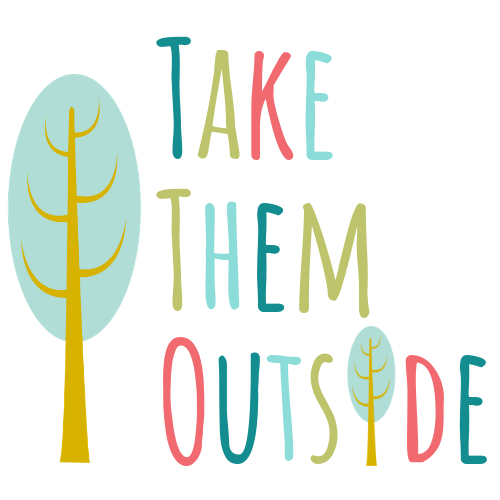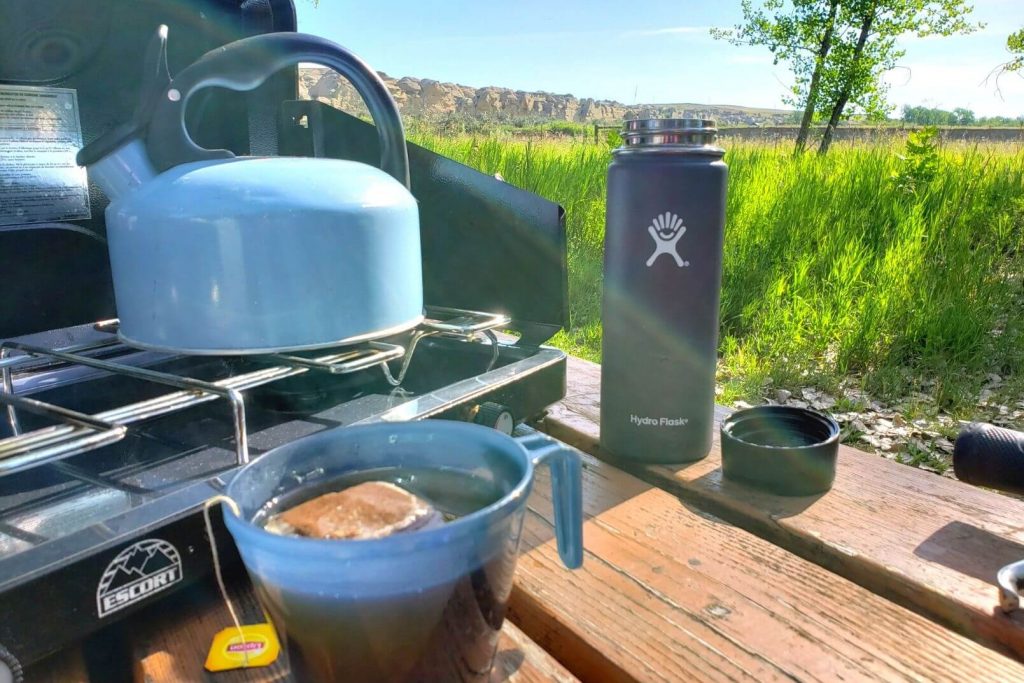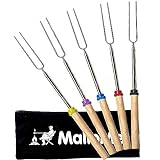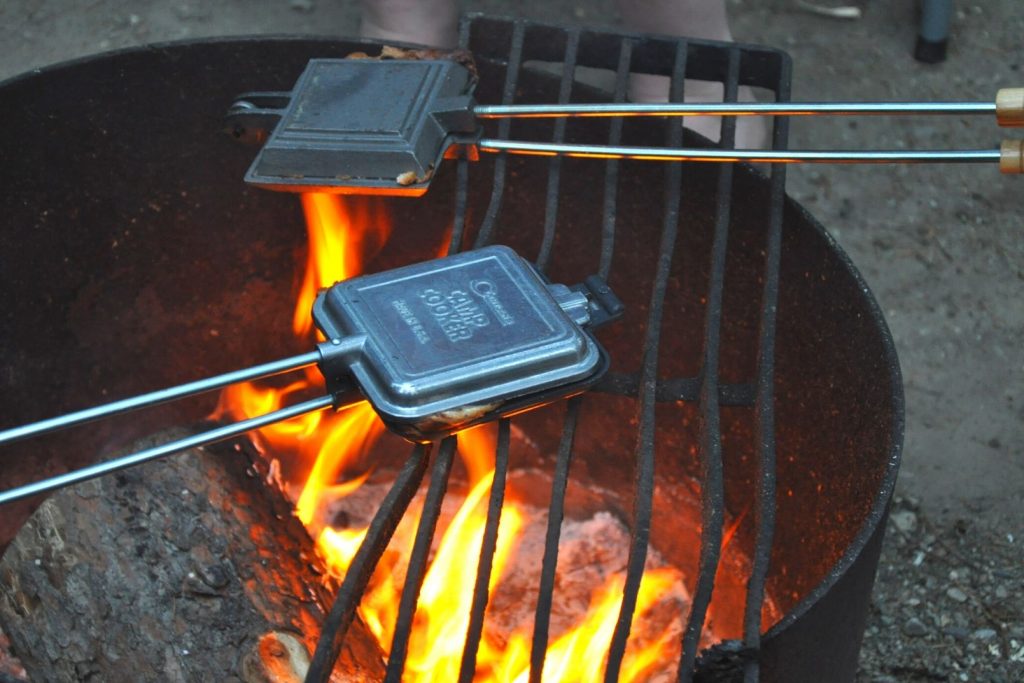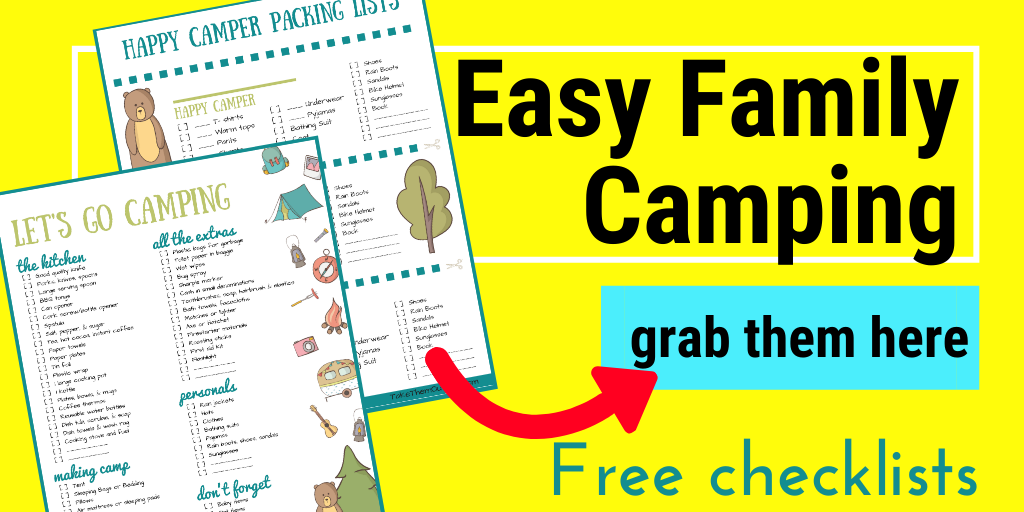If you happen to be like me, camping’s all about being outside, enjoying a drink by the fire, and eating! Right?
But, for those of us without refrigeration, the planning and preparation involved with eating can quickly become a huge brain teaser! And, even if you do have power and a big camper for all your kitchen gear, the planning and prepping can still be a huge headache!
Below you’ll find a list of the camping cooking essentials. And, along the way, you’ll also get tips for meal planning, prepping, packing, organizing, and more!
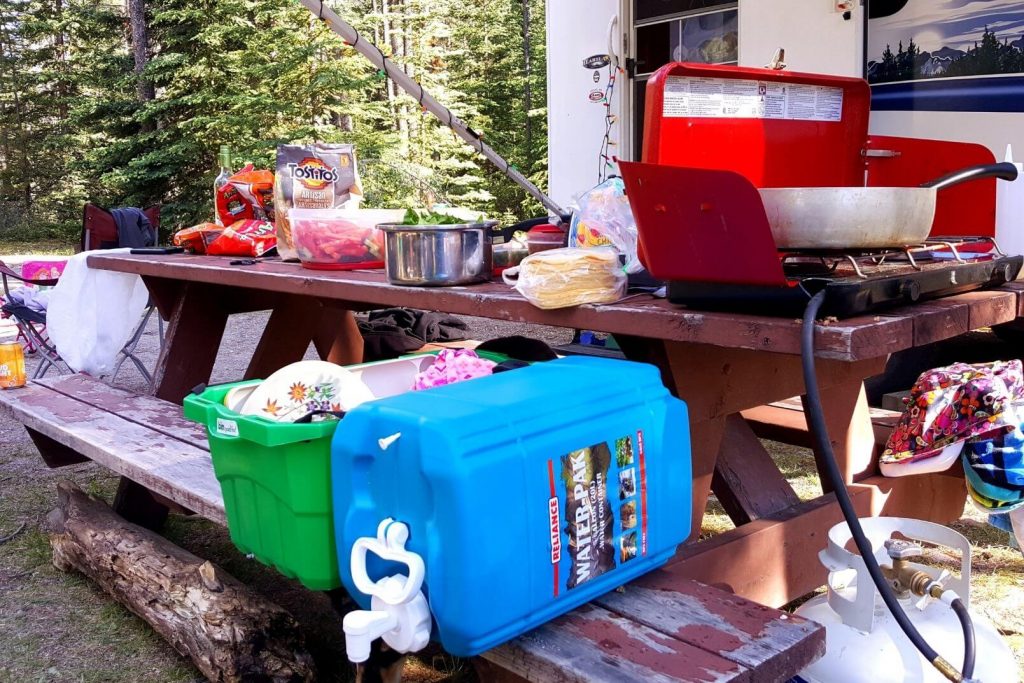
(This post contains affiliate links for your convenience. As an Amazon Associate I earn from qualifying purchases. If you make a purchase through my link I receive a small commission at no added cost to you. See my policy page for more information)
What do I need for a Camp Kitchen?
Having a well-stocked, but not over-stocked camp kitchen is the key to easy camping cooking and eating! You’ll need to differentiate between items you really need, items you want, and what is simply a luxury… and whether or not you can go without those luxuries for your camping trip.
1. Good quality knife:
You don’t want to find yourself slicing a watermelon with a cheap 3 inch paring knife. Knives with their own holder or sleeve will protect fingers when digging through the camping kitchen.
2. Forks, knives, spoons:
Make sure there’s one of each for each member, then throw in a few extra for serving and cooking
3.Large serving spoon and spatula:
Long-handled utensils makes it easier and safer to stir stew and flip pancakes over the campfire
Thrifty tip: Looking at used stores and garage sales is often a great place to find camping cutlery, kitchen tools, and such
4. BBQ tongs:
Helpful in getting foil packets and hotdogs off the campfire grill
5. Can opener, cork screw/bottle opener:
Hand-held, basic ones will do. Even if you don’t plan to have any food items needing these tools on a particular trip, at some point, on some trip, you’ll be glad you have one!
6. Kitchen Food / Drink Basics:
Pack some small quantities of some kitchen basics… just throw these into your camping kitchen tub for the whole season instead of packing them each trip: salt, pepper, sugar, tea, hot cocoa, instant coffee, drink crystals.
Tip: if you are using up some take-out packs of sugar and salt in little paper bags, or tea, and hot chocolate in paper bags – put them all in a small watertight container first. Trust me. Just do this.
7. Paper towels:
Handy for messy spills… and unexpected accidents.
8. Paper plates:
Having a few of these are helpful for serving food to unexpected guests or for putting really greasy foods onto, like bacon or sausages.
9. Tin foil:
You’ll need good quality foil if you plan to cook packs over the fire.
10. Large cooking pot:
If you’re a large family or plan to do more involved cooking you may want to bring a few pots. Second-hand camp cooking pots are great, lightweight options for camping. You might find a set with different sized pots and a fry pan included.
Read More: Check out our guide to camping cooking kits – this will help you find the perfect set!
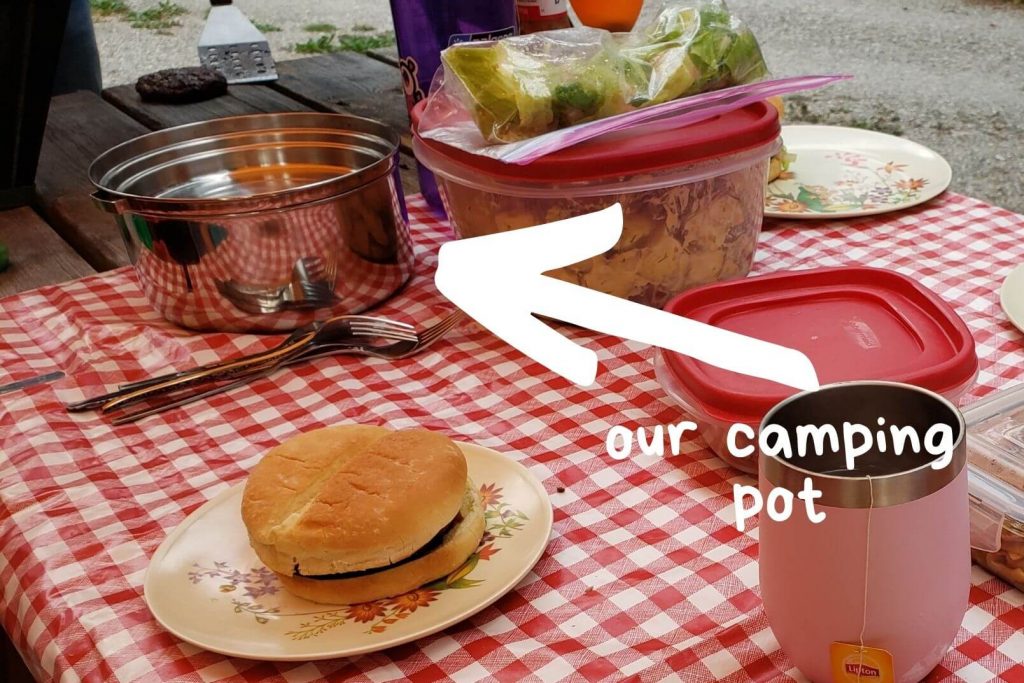
11. Kettle:
When boiling water over a propane stove or the fire, it’s handy to have a proper kettle, but you can always use a regular old pot to boil water for tea and washing up.
Read More: All about camping kettles – which one do you need? And, how to boil water when camping?
12. Plates, bowls, & mugs:
One for each person plus a few extra for cooking and serving.
Read More: Our favourite enamel camping mugs!
13. Thermos:
In cold weather it’s nice to have a thermos to keep your hot drink warm for longer. You can also keep hot water in one of these to have warm water on hand for washing up if you’re camping and don’t have access to hot water taps.
14. Water Jug & Reusable water bottles:
A labelled or easily identifiable water bottle for everyone is a convenient way to keep everyone hydrated without creating an over-abundance of dirty glasses. You may also want to bring a large water jug to keep drinking water available at the campground.
15. Dish tub, scrubie, wash rag, dish towels, & soap:
Unless you plan to haul all your dirty dishes home, you’ll have to wash them at the campsite. You’ll find it easiest to have 2 or 3 tubs for washing, towels to lay the dishes on to dry, a scrub pad, and a wash cloth. But, you might luck out and be camping at a campsite that has an actual wash station with running hot water – I love these!
16. Cooking stove and fuel:
Even if you plan to use the campfire for all your cooking, it is advisable to have a camp stove with you in case you are unable to have a fire. This could be the typical propane camp stove with 2 burners and a small fuel tank. Or, a lightweight backpacking single burner stove. If you have a stove in your camper and are comfortable using that for all your needs, then you won’t need one of these.
17. Plastic bags for garbage:
You’ll need to keep your garbage packaged and away from animals. The best way to do this is to use the provided garbage dumpsters at the campground. Some campgrounds will have recycling facilities as well.
If you’re wilderness camping (boondocking), keep your garbage in a sealed bag, in your vehicle or in the animal safe location you keep all your food. Large black garbage bags can also be turned into rain ponchos, dry sitting spots, makeshift rain shelters, and for bringing home dirty and wet clothes.
18. Wet wipes / Hand Sanitizer:
These are good to have on hand when preparing food or for quick clean ups before snack time. I like to have antibacterial wipes or hand sanitizer with me to clean my hands after handling meat or for having the kids use them if they’ve got into sometime questionable… they’re also handy for potty clean-ups!
If you are camping and using an outhouse, it is smart to include a small bottle of hand sanitizer into the baggie with the toilet paper. Or, go ahead and leave one in the outhouse if you’re willing to share!
19. Sharpie marker:
You never know when you need to write on something!
Read More: My super mom tip: write the campsite number on all kid’s hands… get more great tips here!
20. A way to manage left-overs:
Plastic wrap (or reusable bowl covers) helps keep left-overs for the next meal. You could also pack some plastic Ziplock bags or throw in some used plastic containers from yogurts or margarine or something… easy, cheap, and disposable if needed.
A few baggie clips are also super handy to have!
21. Matches or lighter, fire starter materials:
It’s always important to have a lighter or matches on hand for propane stoves and for lighting candles, and camp fires. As for fire starter materials, just fill an empty cereal box with lightweight cardboard, egg cartons, and newspaper. You can purchase some fancy fire starter blocks too if you prefer those.
22. Axe or Hatchet:
If you plan on having campfires, you’ll likely want to split some smaller wood for fire starting. They also come in handy for pounding stakes into the ground and chopping large pieces of wood into more manageable and easier-to-burn sizes.
23. Roasting Sticks:
In a pinch you can probably use a long thin stick, but keeping some roasting sticks in your camping gear is easy, especially if you find some with telescoping handles.
Tip: Tuck the roasting sticks into an empty gift wrap tube to protect your gear from their soot, dirt, and stickiness.
The following items may or may not be camping cooking essentials – you decide!
24. Coffee maker:
Most campers bring coffee peculators to use on a stove or over the fire. If we’re car camping with a tent we will likely just use instant coffee and a kettle to boil water. But if we’re camping in the camper, we’ll bring our small stove top coffee maker.
25. Pie Iron:
These are for making pressed sandwiches over the fire. Cast iron ones are heavier to hold, but heat more evenly than the aluminum ones.
Read More: The yummiest apple cinnamon pies for cooking over the campfire or here’s a whole bunch of wonderful pie iron recipes for eating any time of day!
26. Dutch Oven:
This is a popular cooking pot for making anything from stews to breads over the campfire.
Read More: 19 of the best Dutch oven recipes for over the campfire
27. Folding Table:
If your campsite doesn’t have a picnic table, having your own will be very handy. Some like to bring an extra table for outdoor cooking and food prep and set up a permanent outdoor cooking area under an awning or shelter.
When it comes to outdoor camping kitchens, things can quickly get a little out-of-hand (in my opinion). Really, all you need is a cooking surface, access to heating and water, and a food storage system.
But, if you like the idea of those fancy camping kitchen set-ups, then go for it!
Camping Kitchen Storage Ideas:
My number one tip: Use tubs and bins!
By putting all your camping kitchen essentials into one or two designated (and well labeled) kitchen tubs, you’ll find cooking and eating a much easier task.
- Tape a list of the bin’s contents to the lid
- Put like thigs together (cooking items / eating items / cleaning and emergency items)
- You can use a bin for non-refrigerated foods
If you are tenting and also using the back of your vehicle to store gear, a 3 tier plastic drawer system might be handy.
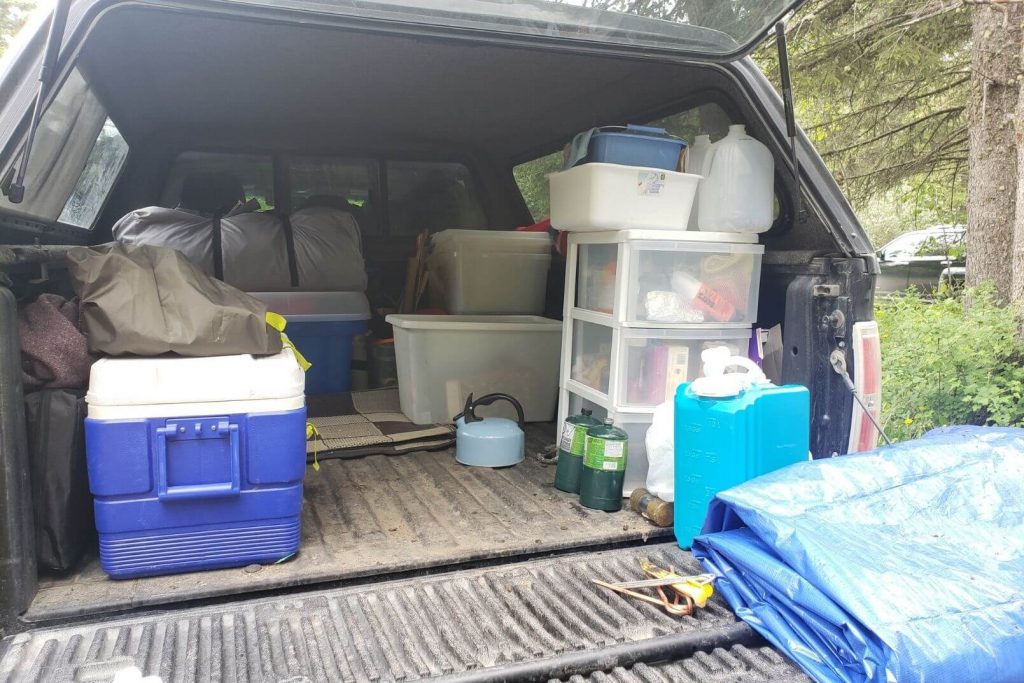
In this picture above, we did almost all of our camping cooking and preparations right on the tailgate. Everything was always close at hand this way.
Tip: If you keep permanent camping bins, use these list labels on the lids to also mark which items need replenishing, which have been removed, which need to be replaced… this will save you digging through before each trip trying to remember if you took out your favourite cork screw or if your salt is running low.
Read more: Practical camping organization and storage tips in these two articles – The guide to lazy-mom camping (how we pack and organize), and camping storage and organization tips from a camping mom!
How do I organize my camping kitchen?
If you’d like to go a step up from basic bins and tub, your possibilities are endless… just take a look around your large camping supply store! You can purchase kitchen set-ups then add expandable shelving, outdoor lighting, pumped water systems, various stoves, ovens, and specialty camping tools.
And if you have electricity, you could bring along your slow cooker, toaster, and coffee maker too!
But, Take Them Outside is about making outdoor adventure simple, easy, and fun (and hopefully a bit more affordable). So, there’s not going to be much discussion about electric appliances and fancy-pants pop-up camping cupboards.
Instead, I’m going to stick with suggesting camping tubs and below are a few recommendations for organizing a simple, but functional car camping kitchen.
Remember: A bear safe campground is a bare campground. Never keep food or cooking stoves and dishes outside at your campground unless you’re currently using them.
Setting up your camp kitchen:
Your cooking surface: Hopefully your campground has a picnic table or you’ve brought along a folding table. If in the absence of these, you can use a tarp or a large garbage bag on the ground, or the tailgate of your truck.
A tablecloth? If you are concerned about the cleanliness of a campground picnic table, bring along an easy-wipe tablecloth to use. Do not use a fleece-backed tablecloth. The wood’s surface will snag on this fleece, making a stringy mess – trust me on this one!
Sanitize: Always wash hands with soapy water or use hand sanitizer (or sanitizing wipes) prior to preparing food. Some people keep a large water jug at their campground for easy hand washing, or a large thermos of hot water may be nice to have available.
Your stove / fire: Set up your camp stove out of the wind, if possible, or make sure to use the wind shield if you have one. It is also good practice to bring along a fire-extinguisher if you are cooking with a propane stove. Many campers have fire-extinguishers in them.
Easy Access: Pull out your camping kitchen tub or organizers and have these close at hand.
The helpful tote: Or, if you are using a camper without the tub system, fill a small tote with only the items you’ll be needing for preparing and eating that meal and only bring those out to your camp kitchen table. Spending a few minutes thinking about this and filling the tub in the camper can decrease the number of times you have to run back into the camper for each new item you need.
Dirty Dishes: Also bring out (or have close at hand) your dirty dish tub during the meal prep stage to put dirty dishes into as you use them. Then, when it comes to washing afterwards they’re already collected into the dirty tub.
How to Wash Dishes when Camping:
There are a few common ways to wash dishes when camping. But, whatever method suits you, our ultimate goal here is to go from dirty dishes to clean dishes with minimal effort!
The basic how to wash dishes when camping:
- Get as much food stuffs off the dish before cleaning
- Fill 2 tubs with hot water, one with soap, one without
- Lay a kitchen towel on the table nearby
- Start by cleaning the cleanest dishes first – usually cups and cutlery
- Wash in the soapy water, rinse, then air dry
- End by washing the dirtiest dishes
- Dispose of your wash water appropriately
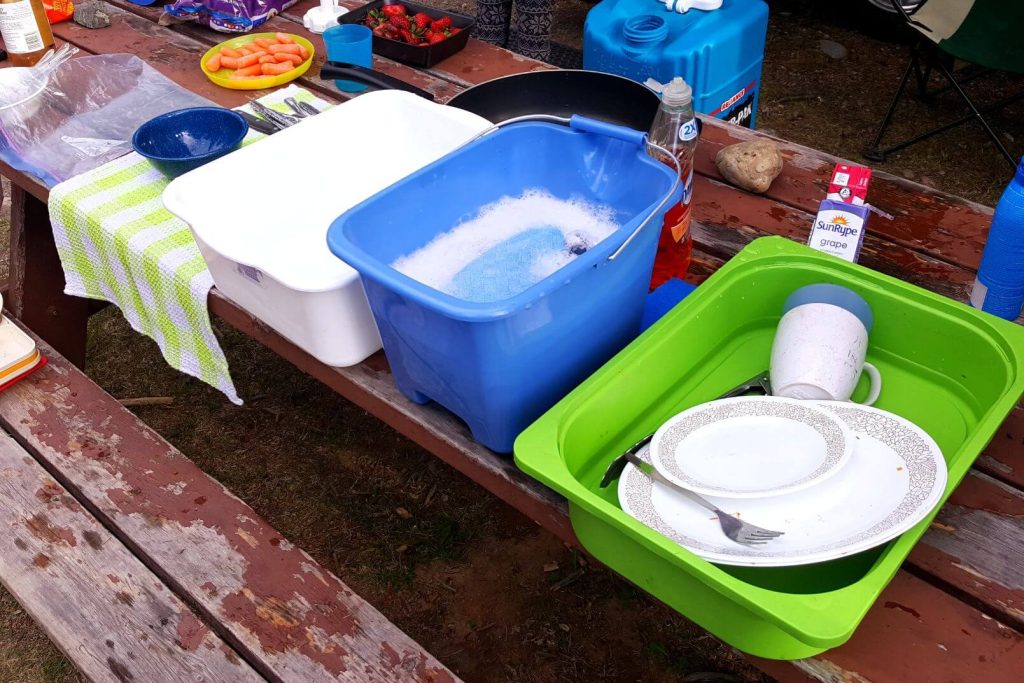
A few more dish washing tips:
- Use a pre-rinse for super dirty dishes.
- Bring a few clothes pins to hang your towels and cloths to dry after using
- Save up your dishes and do one big wash at the end of the day
Read More: See how we wash our dishes when camping and get even more tips and more detailed information here!
How to Cook when Camping?
Cooking over a fire:
There’s a certain appeal to cooking your food over an open fire… and, everything always seems to taste so much better!
Make fires only in the designated camp pits. Some campground will even have cooking shelters with wood stoves for cooking food.
Unless you’re using a wood stove, generally, a campfire is best for cooking after it’s gotten big and hot and has a good bed of coals. Wait for the flames to die down and then put your food on. If flames are licking the pot or foil packs, you are liable to get some burning and uneven cooking.
If there’s a grill provided, use that. If not, well, that’s tricky. You can fashion some sort of tripod over the fire if your pot can hang by its handle. Otherwise, you might want to try foods that you cook on a stick or in a pie iron. You could even try setting your dutch oven or kettle right onto the coals.
And, if you plan to camp there again, purchase yourself a portable camping grill to make things easier.
Remember: Rotate your food frequently because of the uneven heat when cooking over flames.
Tip: Long-handled utensils and oven mitts are handy to prevent you from burning your fingers!
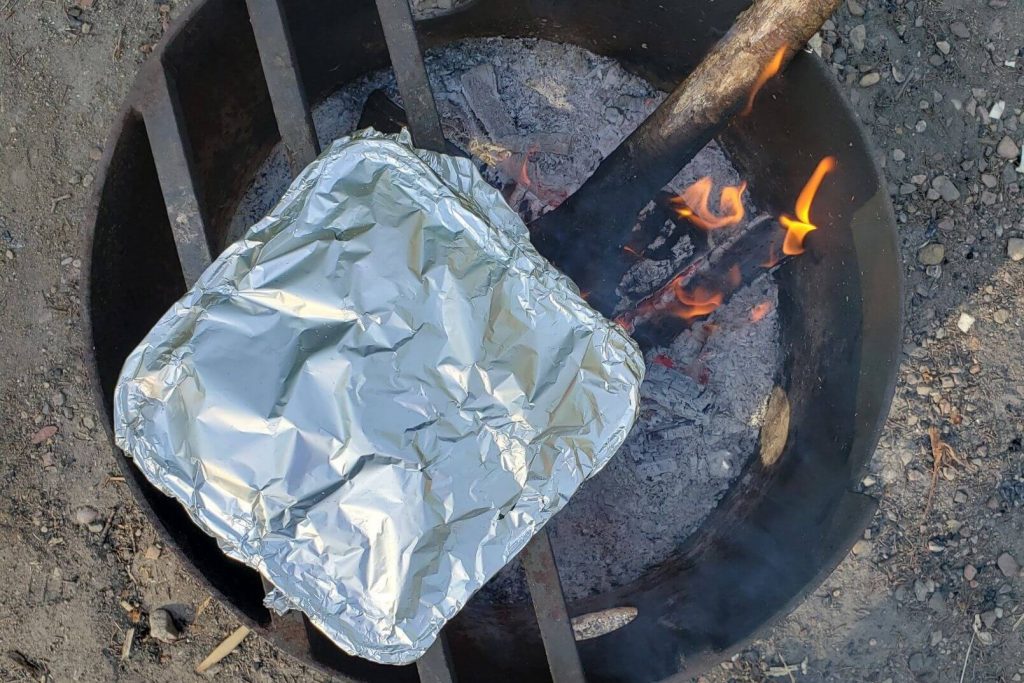
Cooking on a stove / grill / BBQ:
There are a whole bunch of different stove options for camp cooking these days. If you’ll be using one of these gas-powered options, here are a few tips:
- Make sure you have enough fuel for the camping trip.
- Bringing along a bit of extra fuel is always a good idea!
- Try to set up your stove out of the wind or create a bit of a wind break. This will save on fuel and make cooking easier.
- Some campgrounds do not want you using grills on their picnic tables because of the grease that might drip from them.
- Cooking will be more consistent and likely quicker if using a gas-powered stove.
What will you eat camping?
Just a few mentions here…
It is super important to meal plan:
This will save you from bringing more (or less) food than needed. It will also help you organize your food and make sure you actually have everything you need for the meals you do plan on eating.
The Basics of How to Make a Camping Meal Plan:
- On a sheet of paper, write down all the meals and snacks you’ll be needing to eat at the campground
- Beside each meal jot down the foods you’ll eat at that meal
- Make sure to bring this list to the campsite with you
You should also use this meal plan to create your grocery list and your ‘food prep’ to-do list.
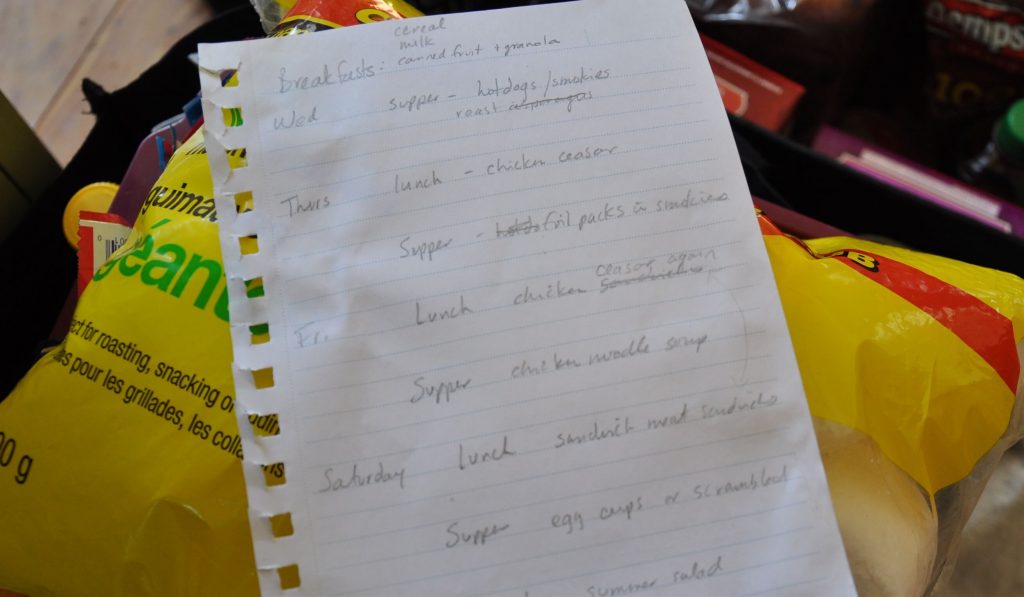
Read more: Making Meals so much easier with camping meal planning and prepping tips, and you’ll find some tips on organizing and storing food here. You may also want to read tips on how to keep your RV fridge cold while travelling.
Some great camping recipes you might want to try:
- Campfire Pita Pizzas
- Our kid’s favourite: Tacos in a Bag
- Egg cups, basic or fancy them up!
- 26 Camping breakfast ideas from easy make-ahead to the full brunch spread
I hope you found this guide to camping cooking essentials helpful! If you think I’ve forgotten something, feel free to leave a comment below and let me know:)

